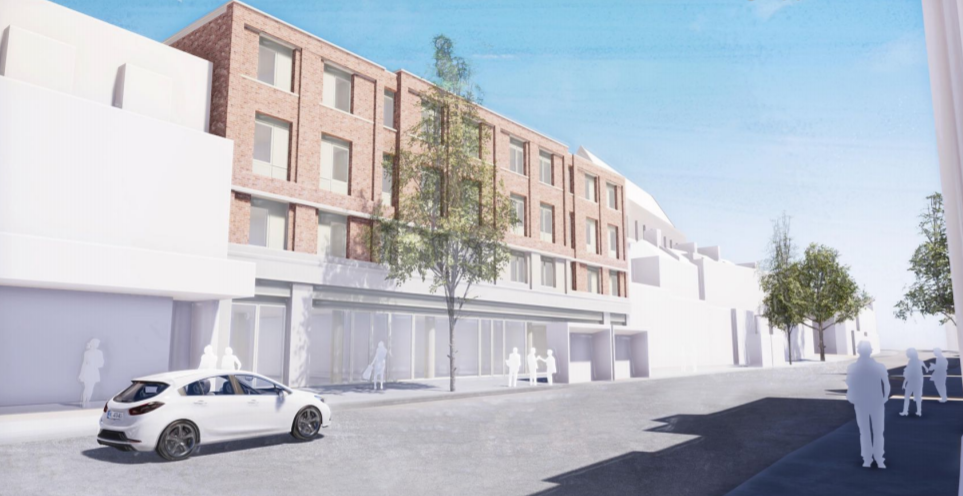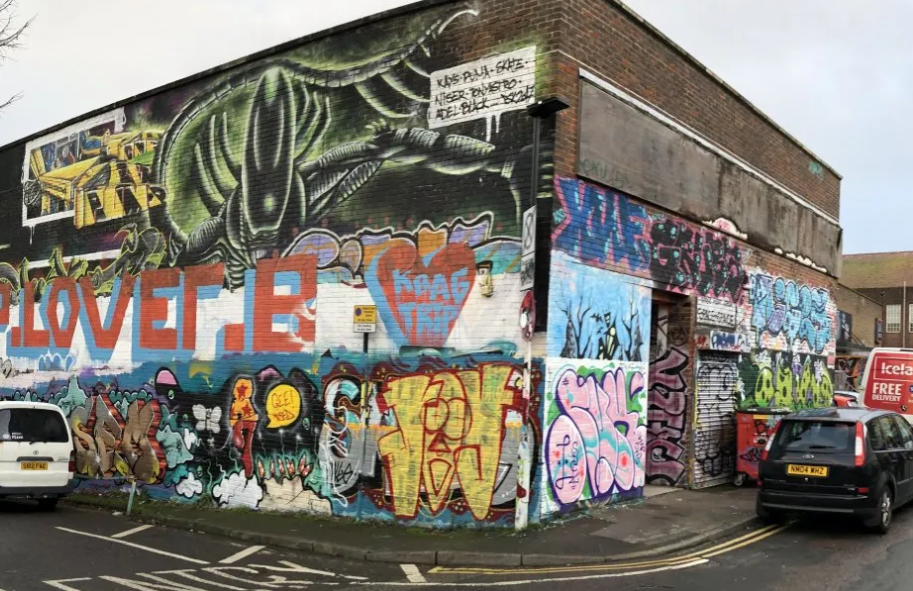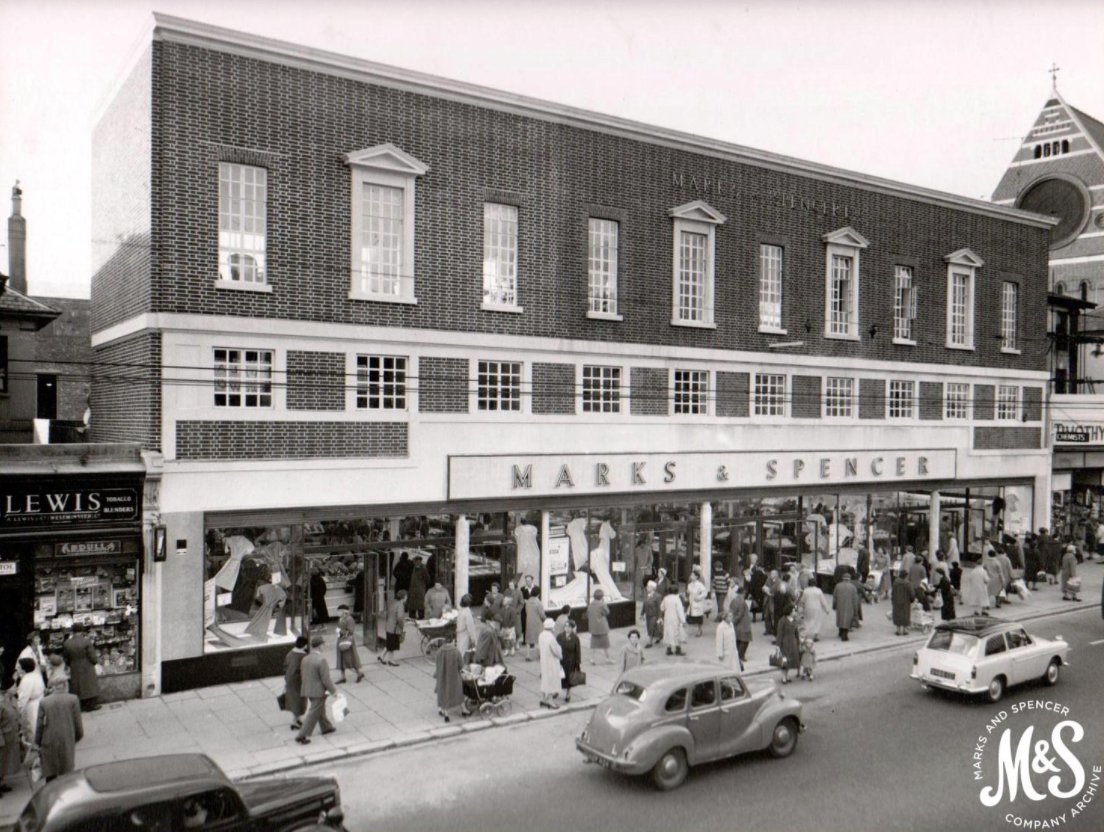Plans for 156 more student flats in London Road, Brighton, have been approved despite concerns that they would lead to pollution worsening.
Clean air campaigner Adrian Hill spoke out about the scheme to demolish the former Marks and Spencer store and replace it with a five-storey block, citing high levels of air pollution.
Mr Hill, a member of Clean Air for Brighton and Hove, told councillors this afternoon (Wednesday 10 February) that the proposed block would make matters worse.
But Brighton and Hove City Council’s Planning Committee backed the proposal by McLaren Property to build more student housing on the plot next to the Aldi supermarket.
Councillors were told that pollution there was higher than the legal limits because of the number of buses stopping along London Road.
Mr Hill told a virtual meeting of the Planning Committee that in 2019 a diffusion tube measuring pollution levels outside the building found that it was the second-worst in Brighton and Hove for nitrogen dioxide – after North Street – and the sixth-worst in the south east.
He said: “Vulnerable groups use the bus stops, such as primary school children and patients at the medical centres.
“The area is in social deprivation because of the air quality and this will make it worse.
“Brighton’s second-most polluted spot, 54 per cent over legal limits … it is no place to live and no place to worsen pollution.”
The council’s air quality manager Sam Rouse said that he was concerned about a proposed communal gas-fired boiler for water heating and a back-up diesel generator, preferring combustion-free energy sources.
But he raised no objections based on the traffic levels outside the building.
McLaren’s air quality expert Frances Marshall completed an air quality assessment for the scheme, looking at the effects of traffic and the energy plant.
She said that, after using recognised methods recommended by the Department for Environment, Food and Rural Affairs (DEFRA), the scheme would have no impact on pollution.

One neighbour, Judi Lynn, of nearby Providence Place, spoke in support of the plan to build the student flats above a new row of shops.
She said that Providence Place was full of drug dealers, litter and graffiti – and the proposed student flats, with its security and glass doors, would be an improvement.
Mrs Lynn said: “This development I see as an extremely important part of this. I do believe there is a need for student housing.
“I would like to see them out of HMOs (houses in multiple occupation) and in proper places that are suitable for them.”
She also praised the design for echoing the brickwork of nearby St Bartholomew’s Church.

Conservative councillor Joe Miller said: “Providence Place is ugly and horrible to walk past, right in front of Brighton’s grade I listed church.
“Anything there would improve it and this is a significant improvement on the Providence Place side, as we have heard, quite passionately from the resident.”
Labour councillor Nick Childs said that London Road used to be an attractive shopping area and could be again, adding: “What that requires is greater footfall, a greater number of people with spending power in the area.
“I have got some concerns about a monolithic student block. I don’t like them that much. But the retail space is being preserved.”
He called for quicker action to deal with air pollution problems.

Independent councillor Bridget Fishleigh was the only member of the committee to vote against the plans.
She said: “We heard from the council air quality expert that he does not know if nitrogen dioxide levels will be down to the legal level by the time this building is occupied.
“I just can’t vote for other people’s children to be poisoned while they’re living and sleeping.”
Green councillor Sue Shanks, who represents St Peter’s and North Laine ward, which includes the site, abstained from the vote, describing herself as “very torn”.
The area needed improving, she said, but retail was failing and students were studying from home.
Councillor Shanks said: “I think it will change. In most European cities people don’t travel all the way to Edinburgh to go to university. They find something local.
“We have two local universities where people can learn. That’s my concern. By voting for something like this, we are saying this is how things are. But things are changing rapidly.”

McLaren Property development director David Atherton said after the meeting: “This is a very pleasing result and one that will help deliver positive change to this part of the city.
“I would like to thank all those who have contributed to the proposals, particularly those in the local community who have engaged with us during the design stages.
“This new development will remove a dilapidated building that has sadly been attracting anti-social behaviour and which local residents want to see redeveloped.”
The current tenants of 5-8 London Road are Peacocks, Iceland and Poundland, with M&S having vacated the premises in 1986.








Just a note on McLaren’s air quality expert Frances Marshall completed an air quality assessment & her comment that ‘the scheme would have no impact on pollution’.
The modelling was calculated without the much new taller building configuration in front (co-op) being included in the model. Also the modelling didn’t consider the fact a large gap between the houses would be closed. The gap currently provides a source of air flow that currently helps a little in clearing the pollution from London Road but now the row of buildings on the west side will be further enclosed.
The report wrongly discounted the illegal pollution measurements, I quote
‘it was not possible to locate the site on Google Streetview in order to verify the height or position. As such, monitoring site C18-19 has been discounted from the verification process.’
When is this going ahead?
Buses are not the main problem in London Road, they all meet low emission standards and some can run in electric mode. The pollution is more the result of the congestion which is likely to get worse when shops reopen, now the traffic lanes have been reduced. Last year (before the lanes were reduced) Buswatch asked the Council make London Road buses and taxis only between Aldi and Preston Circus with general northbound traffic re-routed along Cheapside, New England Street and New England Road. We suggested a trial during lockdown 1 to test the impact. Removing through traffic would improve the environment for everyone in London Road and help to make it a more attractive area.
Brighton’s own detailed air quality assessment says that 39% of the NOx emissions comes from buses whereas 20% comes from cars and taxis.
The buses do not run in electric mode on London Road and, as the buses are 100% diesel and non plugin, run harder on London Road in preparation for North Street.
Page 29 of the pdf here
https://www.brighton-hove.gov.uk/environment/detailed-air-quality-assessment-2020
On North Street the source apportionment is 63% of the NOx emissions. Buses however are a more efficient mode of travel than the car but much less efficient than walking or cycling.
In the detailed air quality assessment 2020 pdf produced by the council, it shows the percentage emissions from each category. The bus category is the largest source of emissions at 39% whereas the diesel car and taxi category is 20%. If you remove all the other vehicles from the road the pollution will be reduced on London Road but will be spread out elsewhere and not solved, possibly closer to where people live. Congestion is a factor though. My opinion is the buses need to move from fully diesel to fully electric (all the buses are Brighton and Hove buses are fully diesel in Brighton, including the Live & Breathe ones).
The 54 ‘Live and Breath’ buses run in entirely electric zero emission mode through the low emission zone (Palmeira Square to Old Steine) and when in diesel mode the engines usually cut out when stationary. B&H Buses has confirmed plans to extend electric operation on these buses to cover London Road very soon. There are also some fully electric buses operated by The Big Lemon.
When the buses are in diesel mode they charge up and in preparation for the electric mode, they do this on London Road running their engines harder than other buses. Unfortunately I’ve never seen them yet switch off their engines on London Road and I’ve looked many times. The bus signage is incorrect as confirmed by the regulator; they are not extended range electric buses, they are non plug in extended range diesel hybrids; ie fully diesel. They are more efficient than the old non hybrids by at most 20% and the best fully diesel buses for Brighton but they are fully diesel and cannot be plugged in to charge. Public transport is the future for Brighton, however my feelings are that must be accurate in how we describe things otherwise it can mislead people and make further decisions on climate change and air quality more difficult, or worse, the wrong decisions are made causing further problems in the future.
My feelings are we need a park and ride, fewer cars in the city and we also need a city wide ULEZ. We also need electric or hydrogen buses. Our health will be much better after all that! I think we agree on those things and I think they should be our collective focus.
Unfortunately you have repeated an earlier claim that hybrid buses run their engines harder in London Road in preparation for electric mode. There is no evidence they do this, as you already know. I asked Martin Harris, MD of Brighton & Hove Buses last year who said “if that’s what they did I would not have bought them”.
Check the facts:https://www.buses.co.uk/enviro400er-buses. You will see all the battery packs in the video.
When running in diesel mode their Euro VI engines produce 67% fewer NO2 emissions than the buses they replaced, making a substantial contribution towards improving air quality throughout the city.
At least we agree on the importance of public transport, a city wide ULEZ and the need for Park & Ride.
The regulator, Low CVP has said and I quote, ‘they can’t call it an extended range and certainly not an electric bus.’ Hopefully the signage will change soon to ‘diesel fueled non plugin hybrid’ or something like that which is more accurate and less likely to be misinterpreted; although the bus company has known about this problem since at least the 6th November 2020 and has not actioned this. These buses are fully diesel. They do use euro 6 engines which are cleaner but are far from clean and do produce large volumes of NOx and particulates. The amount is best identified by monitoring due to past performance of emission testing being inadequate and this type of bus being unique in type and untested. There is at best a 20% reduction in carbon dioxide emissions…burn diesel and there is no way of not producing CO2 and adding carbon to the atmosphere. The 20% reduction in CO2 is based on a welcome fuel efficiency saving. However, I do agree these buses are a good choice for Brighton as there are few alternatives and the infrastructure for hydrogen or electric is not available in Brighton.
Yup, absolutely agree on the importance of *electrified* public transport, a city wide ULEZ and the need for Park & Ride. Until public transport is electrified an even greater emphasis on walking an cycling is needed.
Which would cause increased pollution on the gridlocked re-routed roads, huge delays and traffic backed up down Valley Gardens.
I can’t believe I just read that.
London road northbound traffic re-routed along Cheapside?
The main A23 route out of the city?
Have we given up on the city welcoming tourists and day trippers?
These sort of decisions have a massive affect on the visitor economy.
Quite incredible.
Are these councillors just visitors brought in to destroy Brighton?
Have any of them been to London Road?
It is already a student haven together with the drink and drug nutters that Brighton seems to explode with.
So I suppose it cannot be any worse.
What a shame, or not.
More congestion will result in more emissions and taller buildings restricting air flow, London Road has been destroyed as a shopping area over the years and is now less and less accessible. As for all these student flats is it not time to call a halt to them, any idiot can see the results of Brexit and this recent pandemic will result in less students. What will then happen to all the empty student flats?
In the planning meeting officers confirmed that the flats are not suitable to be used as anything other than student accommodation.